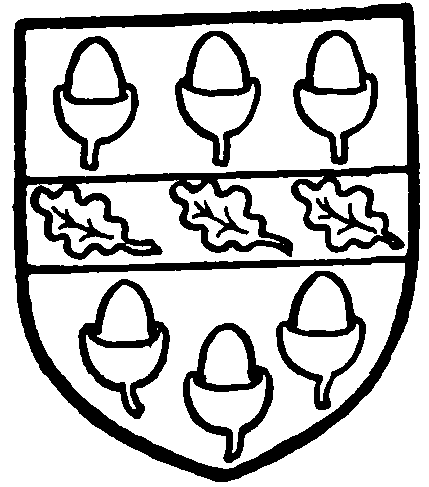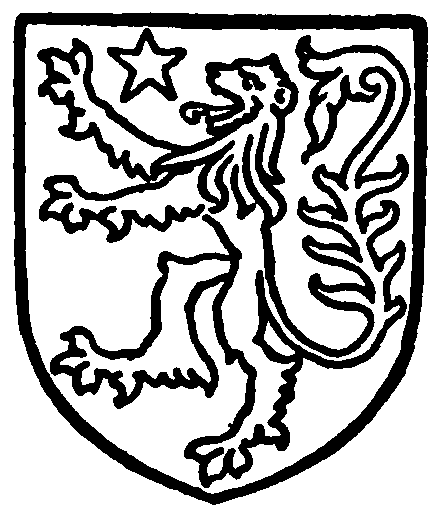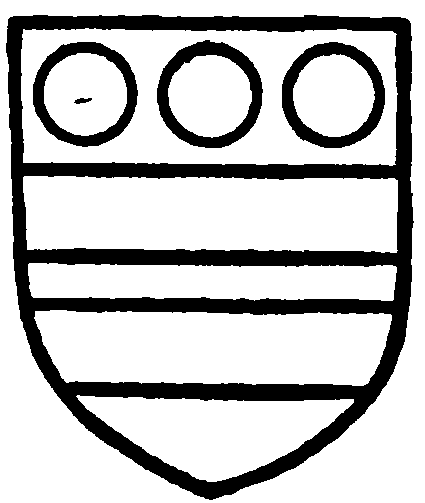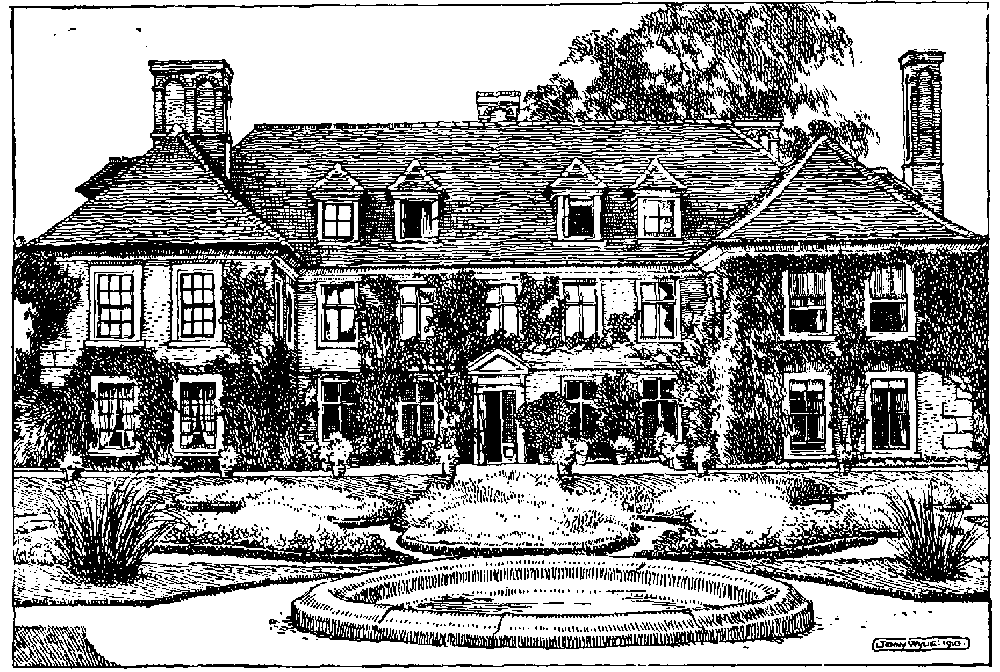Pages 563-567
A History of the County of Hampshire: Volume 4. Originally published by Victoria County History, London, 1911.
This free content was digitised by double rekeying. All rights reserved.
In this section
ELLINGHAM
Adelingham (xi cent.); Elyngham, Aylingham (xiv cent.).
The parish of Ellingham contains 2,558 acres, of which 725¾ acres are arable land, 742¾ permanent grass and 288¾ woods and plantations. (fn. 1) The soil is gravel. The land slopes from west to east from 64 ft. above the ordnance datum near the River Avon to 238 ft. on Rockford Common in the east.
The church, vicarage and a farm lie in a group of trees near the Avon, and are connected by New Bridge with the estate of Somerley on the other side of the river. The main road from Fordingbridge to Ringwood passes east and through the hamlet of Blashford. (fn. 2) The village school is in Rockford, a hamlet almost in the centre of the parish. North of Rockford is Moyles Court, the ancient manorhouse of the Lisles, converted into a farm-house by Henry Baring of Somerley (fn. 3) in the beginning of the 19th century, but restored at a later date by Mr. Frederick Fane. (fn. 4) That part of Linwood which is in the New Forest, and lies between Broomy and Ibsley, is in Ellingham, and is probably part of the hide of land said to have been in the Forest in 1086. (fn. 5)
The parish was inclosed in 1822. (fn. 6)
The ancient place-names include Chappell Field (fn. 7) (xvi cent.).
The township of Broomy, including Broomy Lodge (Major Robert Walker), Broomy New Inclosure Cottage, part of Linwood, Roe Inclosure Cottage, Shobley and Holly Hatch, was described in 1831 as an extra-parochial 'district' not heretofore distinguished. (fn. 8) It was evidently made up of Crown lands in the New Forest, and became a township in 1868. (fn. 9) It contains 4,712 acres, of which about 62¾ acres are arable land, 99¾ acres permanent grass and more than 1,002¼ acres are uncultivated forest land. (fn. 10) The soil and subsoil are clay and gravel.
Manors
ELLINGHAM was held of the king in chief, (fn. 11) the last mention of the overlordship occurring in 1598. (fn. 12)
Cola the Huntsman held the manor in 1086 as Bolne had held it of Edward the Confessor as an alod. In 1160 William de Solers was holding the manor and granted the church of St. Mary, Ellingham, and lands in Ellingham to the abbey of St. Sauveur-le-Vicomte 'for the souls of his predecessors and especially for the soul of Earl Richard, his uncle.' (fn. 13) William was still holding the manor in 1167, (fn. 14) but by the reign of Richard I William de Punchardon was in possession, and, although he was dispossessed by William de Solers about 1194, he recovered seisin in 1199, and William was fined £6 7s. 5d. for his intrusion. (fn. 15) Robert son of William de Punchardon forfeited the manor in 1205, (fn. 16) and King John granted it to Thomas Peverell. (fn. 17) However, it was restored to Robert de Punchardon or to one of his successors, and descended like the manor of Faccombe Punchardons (q.v.) (fn. 18) to Richard Punchardon, who died in 1466–7. (fn. 19) It had previously been settled on his wife Elizabeth, (fn. 20) on whose death in 1499 it was divided between their daughters Philippa wife of Thomas or William Lewston and Anne wife of Thomas Sendy, and William Okeden, son of another daughter Maud. (fn. 21) Philippa Lewston and Thomas Sendy were still holding their shares at the time of William Okeden's death in 1517, (fn. 22) but before 1536 gave up their right to his son and heir John, who made a settlement of the whole manor in 1539, (fn. 23) and died seised in 1558. (fn. 24) Philip son of John (fn. 25) died childless in 1598, and the manor passed by settlement in tail-male to his nephew William son of William (fn. 26) Okeden.
Ellingham belonged to the Okedens until the middle of the 17th century, when William Beconshaw in 1634–5 died seised of the manor, (fn. 27) which passed on the death of his son Sir White Beconshaw in 1638 to the two daughters of the latter, Elizabeth wife of Thomas Tipping and Alice wife of John Lisle. (fn. 28) In 1658 a final settlement by which Ellingham passed to the Lisles was ratified by William Okeden, possibly a grandson of the lastmentioned William, who sold all reversionary right to William father of John Lisle. (fn. 29) This John Lisle the regicide, created Viscount Lisle by Cromwell, was attainted at the Restoration, but escaped to the Continent, where he was assassinated in 1664. (fn. 30) Subsequently Ellingham was restored to his son John, (fn. 31) who died in 1709, leaving two sons John and Charles Croke Lisle, who both succeeded him in turn and both died childless. (fn. 32) The latter, by will proved 1721, entailed his estates on his uncle Edward Lisle, (fn. 33) son of William the elder brother of John Lisle the regicide. From Edward the manor passed in turn to three of his sons, Edward, John and Charles, (fn. 34) the last being succeeded by a son Charles, who died unmarried in 1818. (fn. 35) It then passed to Christopher Taylor, the husband of his sister Mary, who had died in 1800. Their eldest son, Edward Hayles Taylor, who took the name of Lisle in 1822, sold the manor soon afterwards to the Earl of Normanton, (fn. 36) whose descendant Henry James Agar Earl of Normanton is the present lord of the manor.

Okeden. Sable a fesse argent between six acorns or with three oak-leases vert on the Jesse.
A mill, which cannot now be traced, was attached to the manor in 1086 (fn. 37) and 1294. (fn. 38)

Agar, Earl of Norman ton. Azure a lion or with the difference of a molet.
The manor of ROCKFORD or ROCKFORD MOYLES (Rechefort or Rachesford, xii cent.; Rokeford, xiii cent.; Elyngham, xiv cent.; Rokford Meolys alias Elyngham, xv cent.), which Alwi the priest had held of King Edward as an alod, was in 1086 held by Hugh de St. Quintin of Hugh de Port, (fn. 39) and the overlordship was annexed to the St. John barony. (fn. 40)
In 1167 Rockford was in the possession of Robert Taisson or Tesson, (fn. 41) a descendant of the Domesday holder, since Taisson and St. Quintin were used by the family as alternative names. Thus a few years later Walter de St. Quintin granted the chapel of Rockford to the abbey of St. Sauveur-le-Vicomte, (fn. 42) and as Walter Taisson added a grant to the abbey of a tithe of all the crops growing in the marsh near his house. (fn. 43) His son and successor Robert Taisson witnessed a charter of Margery widow of Richard Rivers to Ellingham Priory. (fn. 44) After this date the manor passed to the Moels family, and it seems possible that the Testa de Nevill entry, that Nicholas de Moels held one knight's fee in 'Chardeford' of the old enfeoffment of Robert de St. John, refers to Rockford. (fn. 45) Roger son of Nicholas de Moels was in possession of half a knight's fee in Ellingham in 1280, (fn. 46) and in 1286 Simon Cosyn and Cecily his wife granted him a messuage and land in Rockford which they held in right of Cecily. (fn. 47) Roger died in 1295 seised of land in Rockford held of the heirs of Walter Cosyn, leaving a son and heir John, (fn. 48) from whom the manor descended with Over Wallop Moyles (q.v.) until 1337. (fn. 49) In that year John de Moels died, leaving two daughters, Maud wife of Sir Thomas Courtney and Isabel wife of William Botreaux, (fn. 50) and Rockford, then extended at £13 9s. 4d., was assigned to the latter. (fn. 51) William Botreaux died seised of the manor in 1349, and, since his son and heir William was a minor, (fn. 52) the custody of the manor was granted to William of Wykeham, (fn. 53) and afterwards to Richard St. John (fn. 54) and Ralph Daubeney. (fn. 55)

Moels. Argent two bars gules with three roundels gules in the chief.
In 1375 William Botreaux, then a knight, granted the manor to a certain Walter Clopton for life, (fn. 56) and ten years later settled the reversion on his own son William. (fn. 57) The latter succeeded him in 1391, (fn. 58) but died four years later, leaving an infant son William. (fn. 59) The latter died in 1462, and was succeeded by his only daughter, Margaret widow of Sir Robert Hungerford, (fn. 60) who sold the manor to Robert White, (fn. 61) probably when she was raising a ransom for her son Robert, who had been taken prisoner at the battle of Castillon. (fn. 62) Rockford remained in the White family for some years, passing from Robert to his son John, (fn. 63) and afterwards in 1469 to Robert son of John. (fn. 64) Henry White, son of the latter, (fn. 65) died circa 1535, leaving a son Robert, (fn. 66) who was holding the manor in 1557. (fn. 67) He was succeeded by William White, (fn. 68) apparently his son, who died in 1594, leaving an only daughter, Alice wife of William Beconshaw. (fn. 69) From this time Rockford passed like Ellingham (q.v. supra) to the Lisle family, Moyles Court in Rockford becoming their chief residence. Thus Alice, widow of John Lisle the regicide, continued to live at Moyles Court after her husband's attainder and death until her own notorious trial and death by burning in the market-place at Winchester in 1685. (fn. 70) On the accession of William and Mary her attainder was reversed (fn. 71) and Rockford, which had been granted to Lewis Earl of Feversham, (fn. 72) was restored, like Ellingham, to her son John. (fn. 73)

White. Argent a chcveron gules between three popinjays vert in a border azure bezanty.

Moyles Court, Ellingham
In the middle of the 19th century Edward Hayles Taylor sold Rockford to Henry Baring of Somerley, (fn. 74) from whom it has since been purchased by John Coventry of Burgate Manor. Moyles Court, however, was sold to the Earl of Normanton with Ellingham. (fn. 75)

Lisle. Or a chief azure with three lions or therein.
A water-mill belonged to Rockford Manor in the 13 th century, (fn. 76) but by 1337 was in bad repair, (fn. 77) and in 1349 it was almost in decay. (fn. 78) It is mentioned in 1664, (fn. 79) but no trace of it exists at the present day. The right of free fishing was attached to the manor in the 18th century. (fn. 80)
The Moels family held land in Ellingham, (fn. 81) which followed the descent and became merged in the manor of Rockford Moyles (q.v.).
The alien priory of Ellingham, a cell to the abbey of St. Sauveur-le-Vicomte in the diocese of Coutances, was founded by William de Soleres in 1160. (fn. 82)
Church
The church of ST. MARY (formerly ALL SAINTS) consists of a chancel measuring 35 ft. to the screen and 37 ft. to the wall angle and 14 ft. 9 in. wide, a north organ chamber, nave 52 ft. by 24 ft., a wooden bell turret over the west gable and a south porch. The whole building appears to have been built in the late 13th century, a rood-loft stair turret being added in the 15th century; the south porch and west end of the nave are of red brick and stone and were rebuilt in 1720 and 1747 respectively, and the organ bay is a modern addition.
The east window of the chancel consists of three grouped lancets with a two-centred chamfered rear arch partly restored. The eastern angles of the nave walls have pairs of 13th-century buttresses. In the north wall is a double lancet much restored. In the south wall of the chancel is a trefoiled piscina with a pair of drains, and near it a three-light window with modern tracery. The south door has a two-centred head with a stopped chamfer, and west of it is a 15th-century window of three lights. There is no chancel arch, its place being taken by a screen which by most unusual good fortune retains its contemporary plastered partition above, and the floor and part of the front of the rood loft, the latter being 2 ft. wide, and setting forward in front of the screen. On the plaster partition over the screen the position of the rood which stood against it is clear, and has on either side of it wooden brackets, on which the figures of our Lady and St. John must have stood. On either side are painted figures of angels, and there is a background of a diaper pattern of roses and lilies and a border of dark green foliage. The date of the work is c. 1460. The front of the loft has been closed by a plastered partition on which are painted the royal arms of Charles II, 1671, and a number of texts, &c, in square and oval borders. In the upper tier are the Lord's Prayer, the Commandments in two panels, and the Creed, and below are four texts, James i. 21, Galatians iii. 24, Proverbs xxiv. 21, and Malachi iv. 2, with the royal arms in the middle. The original moulded bressummer carrying the front of the loft also shows externally on the west, and the screen below is of simple 15th-century character, very well preserved, with tracery in the head and solid panels below.
On the north side of the nave is a fine late 17th-century wood canopied pew, originally belonging to the Lisle family, and lighting it a small double lancet in which a few of the stones are old. The wall is set out to make room for the pew, which is not in its original position. West of this are three double lancets, with the north door between the second and third; some old stones remaining in all the windows. The north door only shows externally and has a plain chamfer and two-centred head. At the south-east of the nave a 15th-century doorway with cambered lintel opens into the projecting turret which contained the rood stair. In the wall above is an opening from which the rood loft was entered, though it is now below the level of the actual loft. The turret was lit by two small lights and has a rough external door. West of the turret is a three-light window with wood lintel, only a few stones being old, and the south doorway is partly restored and has a two-centred head with stopped chamfers. The porch is of red brick, dated 1720, and has a large sundial on the gable.
The west end of the church is in brick and stone, dated 1747, and has a window and west door in classical style; the latter is blocked internally by an early 18th-century carved wood reredos, having a Doric order with a broken pediment in which are a dove and lamb.
In the middle is set a very good painting of the 'Last Judgement' brought from Cadiz, and apparently late 16th-century Spanish work; above it are two cherubs' heads and below a sheaf of deeply undercut foliage.
The chancel roof is modern, barrel vaulted in wood, and that of the nave is of similar shape, but has old tie-beams and principals, probably of 16th-century date; it is divided into panels by moulded ribs with gilt rosettes at the points of junction, which appear to be all modern. The bell turret has been rebuilt and stands on trussed beams carried to the ground. There is an octagonal carved 17th-century pulpit, once forming part of a 'three decker,' and the back of a bench with carving of the same date. The altar table is of the 17th century and has carved legs, and the altar rails are of the 18th century. The font is octagonal, probably of the 15th century, but the base on which it stands is of Purbeck marble, and may have formed part of an earlier font. Attached to the rood screen is a wrought-iron hourglass stand dated 1650, containing a modern glass. The only ancient monumental inscription is on a small brass plate to Richard Punchardon (without date), now fixed into the modern stone reredos. In the south wall of the nave is a good marble monument to Alice Beconshaw, 1622, and on the west wall of the vestry three late 16th-century stone panels carved with a scallop and two roses, with two heads, apparently the ends of mediaeval labels, above them in the wall. On the monument of Alice Beconshaw, who was daughter and heir of William White of Moyles Court, are three shields of arms, namely, Beconshaw, Sable a cross paty argent and in the chief a scallop or, with a crescent for difference; White, and the two coats impaled.
In the north-east chancel buttresses are two small crosses and part of an inscription, and a stone half hidden by the buttress appears to be part of an engraved cross-slab. Several other old coffin slabs are also preserved, and on the south-east buttress of the chancel is a mediaeval sundial.
In the nave hang three good 18th-century brass chandeliers.
The one bell is by Clement Tosier, 1712.
The plate consists of a silver chalice of 1652, a paten of 1897 and a flagon alms dish of 1742.
The registers are contained in five books. The first, which has been recently restored, has all entries from 1596 to 1694; the second has all entries from 1695 to 1729; the third has baptisms and burials from 1727 to 1768 and marriages from 1727 to 1753; the fourth has marriages from 1754 to 1812, and the fifth baptisms and burials from 1769 to 1817.
Advowson
The church of Ellingham, in one charter described as the church of St. Mary, (fn. 83) and in another as the church of All Saints with the chapel of St. Mary, (fn. 84) formed part of the grant of William de Solers to Ellingham Priory. In 1294. it was worth £12, (fn. 85) and before 1298 was appropriated to the priory. (fn. 86) At the dissolution of the priory the advowson was granted by Henry VI to Eton College, (fn. 87) to which Edward IV in 1462 (fn. 88) granted also the fruits of the church. About 1880 (fn. 89) Eton College sold the advowson to the late Earl of Normanton, to whose son, the present earl, it now belongs.
A chapel at Rockford, subject to the church of Ellingham, was granted by Walter de St. Quintin or Taisson, with the tithe from his house, to the abbey of St. Sauveur-le-Vicomte about 1170, and mass was to be said there three times a week by the chaplain of Ellingham or a monk. (fn. 90) No trace of it remains, but it probably stood in the 'Chapell field' mentioned in an indenture of 1664. (fn. 91)
Charities
Dame Elizabeth Tipping, widow of Sir Thomas Tipping, knight, by deed of 30 July 1687, appointed for the use of the poor certain lands in Wide Meadow, the rents and profits to be bestowed yearly on St. Thomas's Day amongst eight poor persons with a preference to her poor kindred. The poor receive the rents of 3a. 1r., now known as the Poor's Allotment, averaging about £4 a year.
In 1828 Mary Ann Colthurst directed certain of her property to be sold, and proceeds invested for the benefit of the poor. The trust fund now consists of £333 6s. 8d. consols.
The Harding Almshouses.—Mrs. Robert Harding, who died in 1855, directed £1,000 to be applied in the purchase of land and the erection of almshouses thereon. The endowment fund consists of £406 9s. 8d. consols with the official trustees, the dividends of which are applied in keeping the almshouses in repair and in defraying the expenses of the trust.


